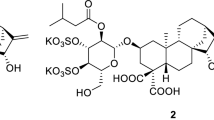Abstract
Benzopyrans (chromenes) and benzofurans are characteristic natural products of theAsteraceae and are found together with their biogenetic precursors primarily in the tribesAnthemideae, Astereae, Eupatorieae, Heliantheae, Inuleae, andSenecioneae. The accumulation of benzopyrans and benzofurans supports an arrangement of the tribes of theAsteraceae into two groups as suggested recently based on morphological characters. The methods for analysing this class of natural products are demonstrated with the American genusEncelia. Experiments on the localization of benzopyrans and benzofurans inEncelia species indicate that these compounds are stored in resin ducts. Several benzopyrans and benzofurans are biologically active and are repellent as well as toxic towards herbivorous insects. Experiments on structure — activity relationships indicate the biological activities as being influenced by the heterocycle (pyranvs. furan) as well as by the substituents of the aromatic ring. In addition, several tested compounds showed phototoxic activities.
Similar content being viewed by others
Literatur
Blake, S., 1913: A Revision ofEncelia and some related genera. — Proc. Am. Acad. Arts Sci.49, 346–396.
Bohlmann, F., Burkhardt, T., Zdero, C., 1973: Naturally Occurring Acetylenes. — London, New York: Academic Press.
—, 1977: A new ageratone derivative fromIsocarpha oppositifolia. — Phytochemistry16, 768.
Carlquist, S., 1976: Tribal interrelationships and phylogeny of theAsteraceae. — Aliso8, 465–492.
Greger, H., Zdero, C., Bohlmann, F., 1983: 6-Hydroxytoxol esters and a secodammarane derivative fromAbrotanella forsterioides. — Phytochemistry22, 2085–2087.
Hegnauer, R., 1977: The Chemistry of theCompositae. — In:Heywood, V. H., Harborne, J. B., Turner, B. L., (Eds.): The Biology and Chemistry of theCompositae, pp. 283–335. — London, New York: Academic Press.
Heywood, V. H., Harborne, J. B., Turner, B. L., 1977: The Biology and Chemistry of theCompositae. — London, New York: Academic Press.
Isman, M. B., Proksch, P., 1984: Repellent and insecticidal chromenes and benzofurans fromEncelia (Asteraceae). — Phytochemistry (im Druck).
Lin, T.-J., Ramstad, E., Heinstein, P., 1974: In vivo biosynthesis of isopentenylacetophenones fromEupatorium rugosum. — Phytochemistry13, 1809–1815.
Proksch, P., Rodriguez, E., 1982: High-performance liquid chromatography of chromenes and benzofurans from the genusEncelia (Asteraceae). — J. Chromatogr.240, 543–546.
Proksch, P., Rodriguez, E., 1983: Chromosomes and benzofurans of theAsteraceae, their chemistry and biological significance. — Phytochemistry22, 2335–2348.
—, 1983a: A new benzopyranbenzofuran dimer fromEncelia ventorum. — Planta Med.47, 224–226.
—, 1983b: Phototoxic and insecticidal activities of chromenes and benzofurans fromEncelia. — J. Nat. Prod.46, 331–334.
—, 1984: Distribution of chromenes and benzofurans inEncelia california. — Biochem. Syst. Ecol.12, 179–181.
—Proksch, M., Rodriguez, E., 1984: Localization of chromenes and benzofurans inEncelia farinosa (Asteraceae). — Z. Naturforsch., Sektion c (im Druck).
Rodriguez, E., Mabry, T. J., 1977:Tageteae-Chemical Review. — In:Heywood, V. H., Harborne, J. B., Turner, B. L., (Eds.): The Biology and Chemistry of theCompositae, pp. 785–797. — London, New York: Academic Press.
Seaman, F. C., 1982: Sesquiterpene lactones as taxonomic markers in theAsteraceae. — Bot. Rev.48, 121–595.
Vyas, A. V., Mulchandani, N. B., 1980: Biosynthesis of precocenes I and II, Anti-Juvenile Hormones. — Phytochemistry19, 2597–2598.
Wagenitz, G., 1976: Systematics and Phylogeny of theCompositae (Asteraceae). — Pl. Syst. Evol.125, 29–46.
Author information
Authors and Affiliations
Additional information
Vorgetragen auf der Tagung der Deutschen Botanischen Gesellschaft, Wien, September 1984.
Rights and permissions
About this article
Cite this article
Proksch, P. Vorkommen und biologische Bedeutung von Benzopyranen (Chromenen) und Benzofuranen in denAsteraceae . Pl Syst Evol 150, 89–100 (1985). https://doi.org/10.1007/BF00985570
Issue Date:
DOI: https://doi.org/10.1007/BF00985570




